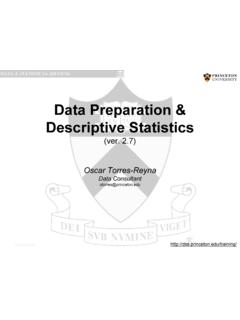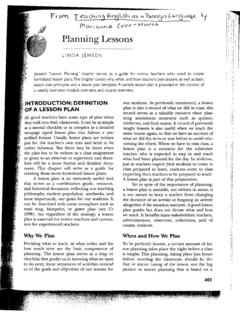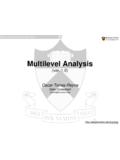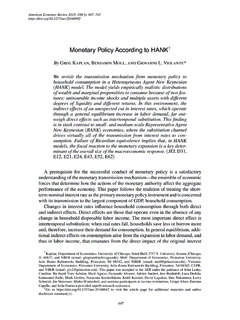Transcription of Differences in Differences (using Stata)
1 Differences in Differences (using Stata)(work in progress)Oscar Torres 2015 Difference in Differences (DID)Estimation step by step* Getting sample " ", clear* Create a dummy variable to indicate the time when the treatment started. Lets assume that treatment started in 1994. In this case, years before 1994 will have a value of 0 and 1994+ a 1. If you already have this skip this time = (year>=1994) & !missing(year)* Create a dummy variable to identify the group exposed to the treatment. In this example lets assumed that countries with code 5,6, and 7 were treated (=1). Countries 1-4 were not treated (=0). If you already have this skip this treated = (country>4) & !missing(country)* Create an interaction between time and treated. We will call this interaction did gen did = time*treatedOTR2 Difference in Differences (DID)Estimation step by step* Estimating the DID estimatorreg y time treated did, r* The coefficient for did is the Differences -in- Differences estimator.
2 The effect is significant at 10% with the treatment having a negative effect. _cons +08 +08 +09 +09 did +09 +09 +09 +08 treated +09 +09 +08 +09 time +09 +08 +08 +09 y Coef. Std. Err. t P>|t| [95% Conf. Interval] Robust Root MSE = +09 R-squared = Prob > F = F(3, 66) = regression Number of obs = 70.
3 Reg y time treated did, rOTR3 _cons +08 +08 +09 +09 1 1 +09 +09 +09 +08time#treated +09 +09 +08 +09 +09 +08 +08 +09 y Coef. Std. Err. t P>|t| [95% Conf. Interval] Robust Root MSE = +09 R-squared = Prob > F = F(3, 66) = regression Number of obs = 70.
4 Reg y time##treated, rDifference in Differences (DID)Estimation step by step* Estimating the DID estimator (using the hashtag method, no need to generate the interaction)reg y time##treated, r* The coefficient for time#treated is the Differences -in- Differences estimator ( did in the previous example). The effect is significant at 10% with the treatment having a negative in Differences (DID)Using the command diff**Inference: ** p< ; ** p< ; * p< * Means and Standard Errors are estimated by linear regression P>|t| *t +08 +08 +09 +09 Error +08 +08 +09 +08 +08 +08 +09y +08 +09 +09 +09 +09 +08 +09 Outcome Variable Control Treated Diff(BL) Control Treated Diff(FU)
5 DIFF-IN-DIFF BASE LINE FOLLOW UP DIFFERENCE IN Differences ESTIMATIONR-square: 28 42 Treated: 12 18 30 Control: 16 24 40 Baseline Follow-upNumber of observations in the DIFF-IN-DIFF: 70. diff y, t(treated) p(time)The command diff is user defined for Stata. To install typessc install diffp value for the treatment effect, or DID for treatment and time, see previous slideType help diff for more details/optionsOTR5 ReferencesIntroduction to econometrics, james H. Stock, mark w . watson . 2nd ed., Boston: pearson Addison Wesley, 2007. Difference in Differences Estimation , Imbens/Wooldridge, Lecture Notes 10, summer Lecture 3: Differences in Differences , Fabian









